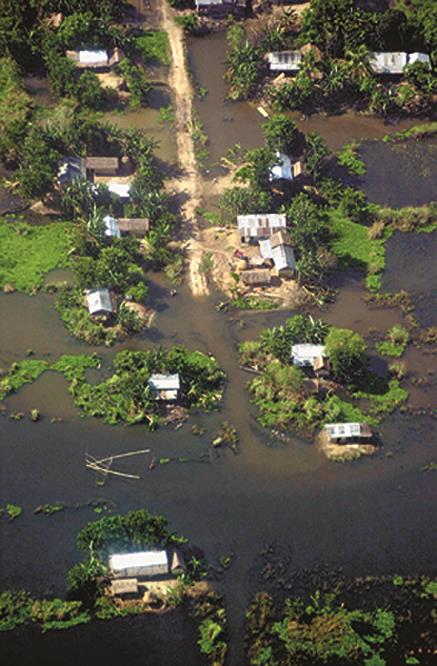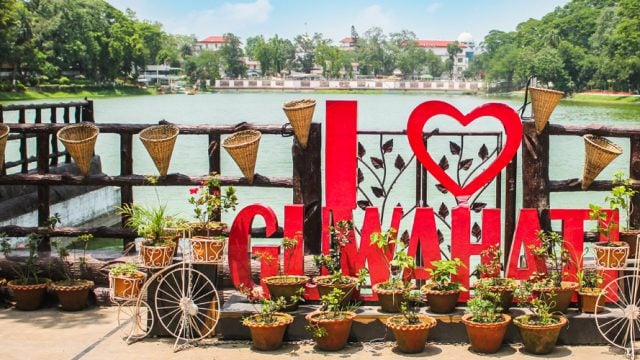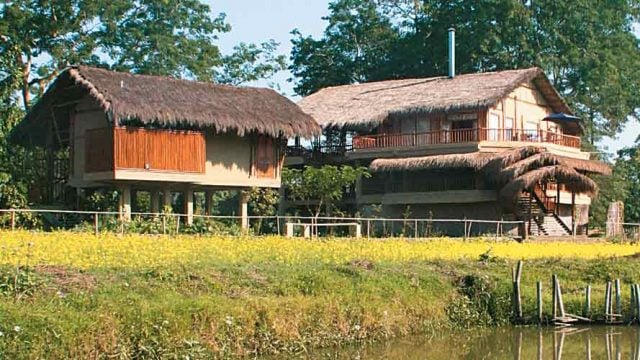The sound of music fills Majuli this time of the year. The dabaa drum calling you to
The island is green, the tall trees in the Vaishnava monasteries are home to the nesting black-headed herons and the now rare greater adjutants. Migrants from Tibet, China and Europe — ospreys, great cormorants and mallards — fill the small freshwater bodies, the beels; ecologists say this winter there are more winged visitors than 2011-12. Satradhikari of Kamalabari Satra, Janardan Goswami points to an increase in visitors of another kind too — foreign tourists.
It takes nearly three hours to cross the river and get to the island, a collection of about 156 mudflats, many submerged in the high Brahmaputra waters. Last September, the breached dyke at Sonowal Kachari inundated about ninety per cent of the land; the flooding was the worst in fourteen years. The river was in spate till early October, affecting around 1.66 lakh people and 75,000 hectares of land. Satras such as Auniati, Natun Kamalabari, Uttar Kamalabari, Bengenaati, Bhogpur, Madhya Majuli and around three hundred naamghars (prayer halls) were also under water. The sand and silt still coat the island in a smooth film when I arrive. The Mishing women still weave their cloth on the high roadsides, keeping their children dry under stilettoed houses.
The private ferry boats that ply four times a day are, at best, mediocre, and often crowded, unlike the all-day boats plying to and from Fort Kochi on the backwaters, for instance. With rising diesel prices, a one-way crossing may cost you anything between Rs 15 to Rs 25, not the meagre Rs 2.50 it costs in Fort Kochi.
The busy Nimatighat, Kamalabarighat and other ghats through which thousands travel between Majuli and the Brahmaputra banks every day are a risky proposition and there is no fixed ghat for Kamalabari — it has shifted twice in the last few months. The Inland Water Transport Department provides no facility and the local people and student unions like the Asom Jatiyatabadi Yuva Chatra Parishad, along with the satras led by the satradhikaris, have been vociferous in their protest at the government apathy.
The Brahmaputra Board is supposed to help plan and implement measures for the control of floods and bank erosion in the Brahmaputra valley. However, the people of Majuli say, the Board has failed miserably in the last thirty years. At a discussion in November last year in Ganeshguri, a former chief engineer of the water resources department, Uken Pegu accused the Board of “telling lies and claiming that Majuli’s area has increased to 520 sq km from 502 sq km in 2004”. The experts at the meet also reiterated that in fifty years there will be no Majuli at the present scale of erosion, which can be judged from the fifty bighas of land washed away in the Bhogpur area last September.
This year, various groups and organisations have repeatedly foiled even a visit to the flooded and erosion-hit areas by Board members, especially along west Majuli. Protestors accuse the Board officials of ‘secret visits’ to Majuli, okaying reports on conservation for which work has not been completed. They have allowed for just one successful meeting of Board officials, MLAs, satradhikaris and local stakeholders last November, giving an ultimatum to the government to complete the work early this year.
The union minister of state for tribal affairs, Ranee Narah, a Member of Parliament from Lakhimpur district in which half of Majuli lies, says, “the chairman [of the Board] has assured me that the erosion and flood management project for Majuli will be completed in 2013.” Three years ago, a Rs 1,700-crore project promised to link NH-52 with NH-37 and build two bridges to Majuli over the rivers of Subansiri and Luit. Narah has also promised a road-rail bridge to Bogibeel by March 2014, election time. However, during the most important festival season, the roads are far from ready.
Getting to the Auniati, Dakhinpat or Chamaguri satras is incredibly difficult, for instance, even though there are more than a hundred SUVs on the island. No bikes and cycles are available on rent. Neither at the ghats, nor at the town centres, does the government provide any maps marking the satras or refer to the distances. And there’s no information on hotels and restaurants to be had. First-time visitors, especially foreign visitors on budget holidays, are left clueless about how to travel and where to go or where to stay. Tourists are often left at the mercy of local youth who demand exorbitant fares for pillion riding on bikes. Besides, there’s not even a clean and proper café on the island, making the arrangement of meals for visitors tricky business. Majuli is far from being a second Puducherry or Darjeeling, floundering instead of catering properly to domestic and international tourists.
The local administration is promising to make amends though — offering to train students as tourist guides now, and teaching them English, Hindi and a smattering of German and French, as there has been an increase in tourist flow from these two countries in recent times. Majuli’s connection with France, in particular, is fairly strong; the Sangeet Natak Akademi, Kalakshetra, the Centre for Cultural Resources and Training and the Embassy of France are engaged in cultural exchanges to promote Ankiya Naat as a storytelling medium, depicting the life of Radha-Krishna, and the numerous dance forms such as Naadu Bhangi, Jhumura and Chaali Naach.
The government has also given grants to a few satras to build guesthouses as satra festivals attract a large number of tourists. The Kamalabari Satra, for instance, is noted for its music, the Auniati for its Pal Nam and apsara dances. Tourists also visit the Chamaguri Satra to learn mask-making.
“Now the satras are not just religious centres. We have other social functions,” says Janardan Goswami of Kamalabari; adding that the main satras are computerised, and are open to teaching languages. “Our satra has also extended relief measures during the recent Kokrajhar violence.” Besides, now a serious attempt is being made to preserve the artefacts kept within the satras since the 1640s — metal utensils of daily puja and personal use, collections of weapons, ivory, wood, clothing from the Mughal era, masks, musical instruments. The government has come up with funding for separate museums at Auniati, Garamur and Kamalabari. In 2013, Majuli will also host the 49th annual conference of the Asom Satra Mahasabha.
“In 2006, the National Manuscript Mission began restoration work on all the sachipats, bark and leaf manuscripts, held by the various satras and digitised most of them,” adds Haridev Goswami of the Garamur Satra. “The Mahi ink used in these sachipats is sometimes three hundred years old, made of hilika and amla juice, gomutra, gums and biological fixers. The sachipats still stand. But to save ancient documents from termites, virulent in Majuli’s salubrious climate, is a herculean task.”
While vigorous efforts are on to preserve Majuli’s heritage satras, infrastructure on the island is abysmal, communication remains a hazard and the fate of its inhabitants, its faith strongholds and cultural heritage hang in the balance. “If Majuli does not remain, do the satras have a future?” ask the satradhikaris.
Brahmaputra
Just Back
Majuli





